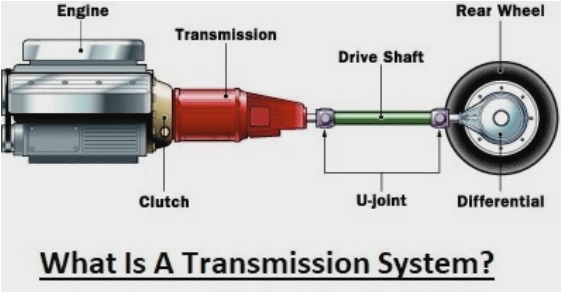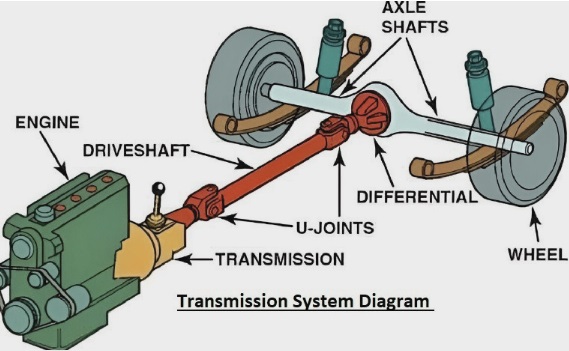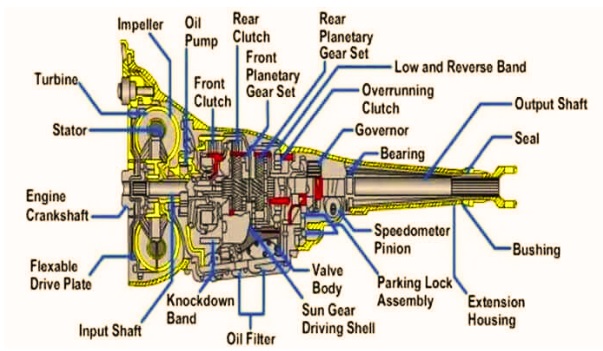Transmission is an important factor for drivers, and these parts are important for the driving system. These transmission parts have different designs and are structured with repair services if they have any faults.
There are different parts of the transmission, and each has its own functions and workings. Here, we will cover details for these parts and their effects on vehicle workings.
What Is A Transmission System?
- The transmission system, also called the powertrain, is a device that sends power generated in the engine of the car to the driving wheels.
- The complete drivetrain comes with a clutch, gearbox, differential, propeller shaft, and final drive shaft that make transmission system.
- Its main use is to transform the speed and torque of the rotating power supply to other devices.
Transmission System Diagram
Functions of the Transmission System
- The main function of the transmission system is as.
- It makes the connection and disconnection part of the engine with the remaining part of the powertrain without any hindrance. It also provides leverage between the engine and drive wheels.
- It is a means of transmission in reverse direction and provides power at different lengths and angles.
- It also reduces speed engine and drive wheel with a ratio of 5/1. It also drives wheels at different speeds if needed.
What Are the Parts of a Transmission?
Torque Converter
- The torque converter is the main component of an automatic transmission. It is the fluid coupling that makes the connection of the engine with the transmission.
- It comes with two main components, the impeller and turbine, which are dipped in transmission fluid.
- When the engine moves the impeller, it makes fluid flow that operates the turbine and sends power to the transmission.
- The torque converter also has a lock-up clutch for making a mechanical connection to increase efficiency at a time of cruising.
Oil Pump
- The oil pump is automatic transmission fluid in the complete system. It provides the required fluid for cooling and lubrication to the torque converter, clutch, and other parts.
- If there is no accurate fluid circulation transmission, it can cause overheating and also any damage.
Planetary Gear Set
- As compared to manual transmission, which comes with different gear is a combination of a gearbox. Automatic transmission comes with one or more planetary gear sets.
- Planetary gears come with a 3-gear set; the main gear is the sun gear and the middle of the planetary carrier.
- The 2nd is planetary gears; there are 3 or more of these gears and configured between the sun gear and ring gear in a mesh network.
- The ring gear about all planetary gears comes with one ring; make a connection of the complete system.
- The system operated with locking 2 of 3 gears set once. Each gear set comes with different sizes that provide a multitude of gear ratios with locking other gears in a single point.
Clutch Packs
- Manual transmission allows you to set the gear, while automatic transmission is a complex system. In place of a manual shifter for getting the required results, the transmission uses a clutch pack.
- The clutch pack comes with different plates in compression form. If the valve body sends oil pressure to the clutch pack, that locks the clutch pack together and gives the required output ratio.
- Different oil pressure set at different values of discs that give gear ratio different values
Output Shaft
- The main function of the output shaft is to transmit power from the transmission to the driving wheels. It makes a connection with the planetary gear set and converts the rotational force produced with the engine to move the car in front or reverse.
Band Brake
- This component is employed for automatic transmission for the application of resistance to certain components. It operated by wrapping around a drum configured with certain gear or shaft and operated with a hydraulic way for controlling gear engagement.
Oil Pan
- It is a reservoir that exists at the lower part of the transmission and contains transmission fluid. It comes with a transmission filter that eliminates dust and other particles from the fluid. It needed maintenance that helps to access and replace the filter, as well as replenish the transmission fluid.
- It is the main part of the transmission, but it needs repairs. The gasket configured between the transmission housing and pan wears naturally with time and needs replacement if there is any leaking in the gasket seal.
Valve Body
- The valve body is the control point of the automatic transmission. It comes with different valves and channels that control the transmission of fluid and also regulate clutch packs and bands.
- The valve gets signals from the computer of the car and sets the hydraulic pressure based on the shift gears in an effective way.
Computer
- In advanced vehicles, computer-regulated transmission works so all vehicle systems operate with each other for getting proper fuel efficiency and working. There are about 30 sensors that read different parameters for reading vehicle speed, engine RPM, and other factors and control transmission shifts for providing optimal shift points.
Types of Transmission Systems
The main types of transmission systems are explained here.
Manual Transmission
- In this system, all gears are manually operated through moveable gear selectors and the driver’s operating clutch. This type of transmission is also called a stick shift or standard transmission.
Automatic Transmission
- The automatic transmission operated with the use of planetary gearsets, torque converters, and bands. They automatically shift vehicles with the use of forward gears.
- The driver also has limited manual control on vehicles with forward, neutral, or reverse mode.
- If the steering button, paddles, or gear selector is depressed, the control operates to upshift and downshift.
- These transmissions are called shiftable automatic, tiptronic, and AutoStick.
Automated Manual Transmission
- The automated manual transmission works like a manual transmission with the use of the mechanical clutch. But there is no need to control the clutch in an automated manual transmission, which removes the clutch pedal.
- Clutch is automatically regulated through electronic, pneumatic, or hydraulic means.
- The other name of this system is Direct Shift Gearbox DSG or Sequential Manual Gearbox SMG.
- It has different techniques like automatic forward gear shifts or manual shifts with the use of the gear selector and button on the steering wheel.
Continuous Variable Transmission
- The continuously variable transmission comes with a variable drive ratio and employs pulleys and sensors.
- We reduce gear wheels for painting a steady acceleration curve without any stops for gear variations.
- It helps to sustain the engine power range and also increases efficiency.
Automatic Transmission System Types
Semi-Automatic Transmission
- Semi-automatic transmission, also known as automated manual transmission or manumatic transmission, has a manual and automatic transmission system.
- These features help to drive manual gear selection without a conventional clutch pedal.
- It has high control for gear selection, which makes it highly efficient.
- In this, the driver uses paddle shifters for gear changing and transmission control clutch engagement automatically.
Fully Automatic Transmission
- It is a common type of automatic transmission that does not use manual gear shifting or clutch control by the driver. It uses a torque converter for smooth and automatic selection and varies gear according to the speed of the car and the load in the car.
- This transmission is used in the latest vehicles.
Continuous Variable Transmission (CVT)
- CVTs are different from other engines and do not use conventional gears. It uses a belt or chain and a set of pulleys to provide an infinite gear ratio.
- It provides simple and smooth acceleration and also increases fuel efficiency.
- CVTs are used in small-sized vehicles and hybrid cars and optimize fuel efficiency.
Dual-Clutch Transmission (DCT)
- Dual-clutch transmission is a high-performance type of automatic transmission. It uses two different clutches, one used for odd-number gears and the other for even-number gears, providing light, fast gear changes.
- DCT is used for fast and accurate shifts and is part of sports cars and high-performance vehicles.
- Drivers can select fully automatic or manual mode and manually shift gears with the use of paddle shifters or a gear lever.
FAQs
What are the main 4 types of transmissions?
- Based on vehicle speed, it modifies the gear ratio for the engine and drive wheels.
- The main 4 types of automotive transmission are
- Manual, automatic, continuously variable transmission (CVT), and dual-clutch.
What is the working of transmission?
- The car gearbox is used for power transmission from the engine to the wheels. It is connected between the engine and the wheels in the powertrain, helps the engine to move fast if needed, and controls the throttle pace for slowing down.
What are the types of transmission?
Types of Transmissions Overview
- Manual Transmission
- Automatic Transmission
- Torque Converter Transmission
- Continuous Variable Transmission (CVT)
- Dual-Clutch Transmission (DCT)
- Direct-Shift Gearbox (DSG)
- Electronic Variable Transmission (EVT)
- Dedicated Hybrid Transmission (DHT)
How many parts are in a manual transmission?
- The manual transmission comes with 3 main shafts; the main shaft, called the output shaft, houses gears, gear levers, and meshing devices such as dog clutches and synchromesh systems.


